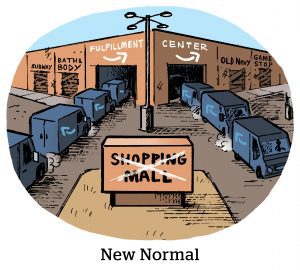There is massive competition among the largest ecommerce retailers to be the quickest, cheapest option online.
Amazon, Walmart and Temu are fighting to be the most cost-effective manufacturers and distributors of relatively low-cost merchandise to people’s doorsteps within a day or two. Not to mention free returns.
Consumers like this trend, because they’re getting cheap stuff, as well as TV entertainment through the likes of Amazon Prime Video and Walmart+, the retailer’s membership program that also includes access to the Paramount+ streaming service.
But not everyone wins here.
The big losers are the mid-tier ecommerce marketplaces, which have been hollowed out over the past few years and have little recourse in this new shopping environment.
The fee limit
Many online marketplaces that carry secondhand, vintage or handmade items – Etsy, Poshmark, Mercari and even eBay – have struggled to devise fee structures that meet the demands customers have for online orders being speedy and easy to return, while also maintaining good relations with sellers on their site.
Temu, by comparison, transports plastic crap across the Pacific Ocean, advertises the heck out of it, offers free shipping on most standard orders in the US, happily processes returns with almost no questions asked, then ships rejected products back across the ocean – and incinerates them. That’s the business model.
Amazon and Walmart, meanwhile, have the deep pockets and national distribution footprints to match Temu’s shipping and return policies, while still winning more share of US ecommerce.
Consider Poshmark, for instance, which this month introduced a totally new tiered fee structure for US sellers and buyers, which has sellers irate. Instead of one relatively large 20% fee on each sale, sellers now pay a 6% “buyer protection fee.” Buyers and sellers each pay additional fees, too, which are to cover Poshmark’s increased costs on shipping and returns. The issue is these fees are now tacked on at the end, which means customers arrive on the purchase page only to discover the price might be much more than they expected.
Even eBay is making big changes. Next year, eBay UK will switch to buyer fees as well, instead of seller fees. This may sound good for sellers, but they’re again worried about customers getting hit with unexpectedly high prices.
AdExchanger Daily
Get our editors’ roundup delivered to your inbox every weekday.
Daily Roundup
And then there’s Mercari, a large Japanese ecommerce company that sells mainly secondhand goods, which eliminated seller fees earlier this year. But it also made dramatic changes to its refund and return policies that allow shoppers to make returns for no reason. Sellers complained about people returning used goods, and Mercari backtracked after only a month to only allow returns if products don’t match their descriptions.
“To say you can return something for any reason,” women’s fashion reseller Gennifer Rose told Modern Retail in April. “I’m not freaking Macy’s, I depend on that money to get deposited.”
The ad angle
But advertising is like a safety valve for the larger players. Growth in ad revenue, which has high profit margins compared to retail sales, can float investments in shipping and returns for retailers like Walmart and Amazon.
Breaking through in advertising for the midfield players is a tougher sell.
Etsy has a nascent ad business. But while Amazon’s ad tech is a default even for brands that aren’t carried on Amazon, Etsy must drag its sellers into advertising. In 2022, Etsy began requiring sellers with more than $10,000 in annual sales to spend on its ad platform. Etsy has dealt with seller strikes due to the policies.
Another problem: Many of Etsy’s biggest advertising clients are Chinese third-party seller accounts that are native to Temu and slip through filters meant to block plastic manufactured products.
Etsy may want to knock all those sellers off its platform, but the ad revenue they generate is mission critical right now. Last month, Etsy was removed from the S&P 500 after its market cap, which peaked at more than $30 billion, dropped below $6 billion.
And Poshmark was in even rougher financial shape last year when it was acquired for $1.2 billion by Naver, a South Korean search engine, after Poshmark shares crumpled by more than half in 2022.
Will online shoppers come to accept longer shipping times for handmade items on Etsy, rather than an Amazon Prime product listing that arrives within a day? Can an online retailer block cynical customers who constantly buy and return items, without frustrating good-faith shoppers looking for a return or refund?
Here’s to Etsy and Poshmark still being around when that happens.













